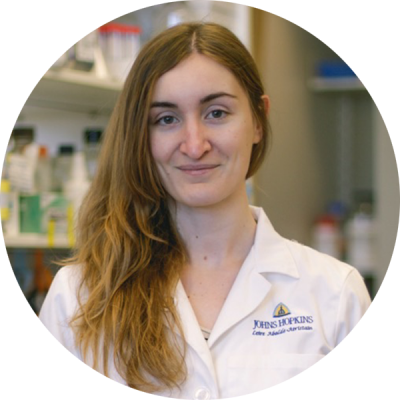
Leire Abalde-Atristain
Cells need to be in tune with their surroundings to decide when it is most favorable for them to grow. A protein called mTOR is key for sensing the availability of nutrients and serves as a switch between energy-producing and energy-consuming cellular processes. mTOR activity is enabled by its association with several proteins into the mTOR complex 1, and tight regulation of this activity is fundamental for the health of cells.
Our research, conducted in the laboratory of Ted and Valina Dawson, has shown that another protein, called Thorase, can dismantle this mTOR complex 1. Mice that lack Thorase have an excess of mTOR activity, which leads to sudden death through a severe neurological condition reminiscent of what we observe in children harboring Thorase mutations. We have found that treating these mice with the mTOR inhibitor rapamycin greatly alleviates their disease. Since this drug and its derivatives are already used in the clinic, we hope that our findings will be readily translatable. Given that our lab has uncovered a broader role for Thorase in the protection of neurons, we believe our discovery will also have implications for other maladies, such as stroke.
Questions & Answers
Why did you choose Johns Hopkins for your work?
When applying to graduate schools, I believed that scientific breakthroughs could hardly be made single-handedly, so I was captivated by the sense of community and emphasis on collaboration emanating from Hopkins when I interviewed for the cellular and molecular medicine graduate program.
What does receiving this award mean to you personally and professionally? Do you have any connection with the particular award you received?
I feel honored and humbled to be chosen for the Martin and Carol Macht award. When I was a first-year student, my rotation mentor in the Dawson lab — Ian Martin — received one of these awards, a career goal I have aspired to ever since.
What contributed to your project’s success?
I am incredibly grateful to Ted and Valina Dawson for nurturing my independence and for their unconditional trust in my ability to drive this project forward. I have also had the fortune to tandem with George Umanah for this work; he is an excellent biochemist and a delight to work with. Likewise, this project has benefited from key contributions from the laboratories of Taekjip Ha and Paul Worley. On a more personal side, I have to thank my family and friends for always believing in me, especially in times of hardship.
What thoughts do you have about Young Investigators’ Day itself, as a celebration of the roles students and fellows play in research at Johns Hopkins?
I think it speaks to the greatness of Johns Hopkins that it recognizes young trainees for their research contributions to science and medicine. As an early career scientist, you can feel very vulnerable, face self-doubt and struggle to find your place in a given field. Therefore, being recognized by your peers provides great momentum to move forward.
Tell us something interesting about yourself.
I was born in San Sebastian, in the Basque Country, a region in northern Spain where we speak Euskera — the oldest living language in Europe. I was raised bilingually and have always enjoyed learning new languages. Had I not chosen to pursue a career in science, I would have trained as a translator and interpreter. Inadvertently, I have ended up investigating another kind of translation — the molecular one — and its role in neurodevelopment and neurodegeneration.